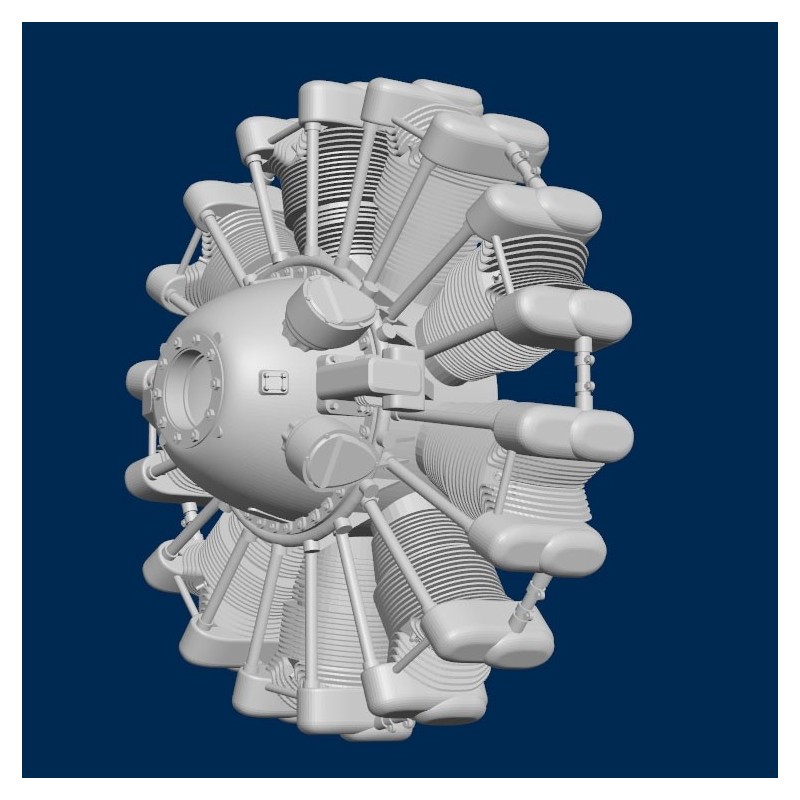




Pratt & Whitney R2800 Twin Wasp Engine
Faithfull replica of the original R2800 ubiquitous USAF aircraft engine
 Security policy
Security policy
All transactions are secured by PayPal / Stripe systems
 Delivery policy
Delivery policy
You can choose tracked delivery to monitor your shipping
The Pratt & Whitney R-2800 Double Wasp is an American twin-row, 18-cylinder, air-cooled radial aircraft engine with a displacement of 2,800 cubic inches (46 L), and is part of the long-lived Wasp family of engines.
The R-2800 saw widespread use in many important American aircraft during and after World War II. During the war years, Pratt & Whitney continued to develop new ideas to upgrade the engine, including water injection for takeoff in cargo and passenger planes and to give emergency power in combat.
First run in 1937, near the time that the larger (54.9 liters) competing 18-cylinder Wright Duplex-Cyclone's development had been started in May of that year, the 46-liter displacement R-2800 was first-flown by 1940, one year before the Duplex-Cyclone. The Double Wasp was more powerful than the world's only other modern 18-cylinder engine, the Gnome-Rhône 18L of 3,442 cu in (56.40 L). The Double Wasp was much smaller in displacement than either of the other 18-cylinder designs, and heat dissipation was a greater problem. To enable more efficient cooling, the usual practice of casting or forging the cylinder head cooling fins that had been effective enough for other engine designs was discarded, and instead, much thinner and closer-pitched cooling fins were machined from the solid metal of the cylinder-head forging. The fins were all cut at the same time by a gang of milling saws, automatically guided as it fed across the head in such a way that the bottom of the grooves rose and fell to make the roots of the fins follow the contour of the head, with the elaborate process substantially increasing the surface area of the fins. The twin distributors on the Double Wasp were prominently mounted on the upper surface of the forward gear reduction housing - with one of the pair of magnetos mounted between them on most models - and almost always prominently visible within a cowling, with the conduits for the spark plug wires emerging from the distributors' cases either directly forward or directly behind them, or on the later C-series R-2800s with the two-piece gear reduction housings, on the "outboard" sides of the distributor casings.
When the R-2800 was introduced in 1939, it was capable of producing 2,000 hp (1,500 kW), for a specific power value of 0.71 hp/cu in (32 kW/L). The design of conventional air-cooled radial engines had become so scientific and systematic by then, that the Double Wasp was introduced with a smaller incremental power increase than was typical of earlier engines. Nevertheless, in 1941 the power output of production models increased to 2,100 hp (1,600 kW), and to 2,400 hp (1,800 kW) late in the war. Even more was coaxed from experimental models, with fan-cooled subtypes like the R-2800-57 producing 2,800 hp (2,100 kW), but in general the R-2800 was a rather highly developed powerplant right from the beginning.
The R-2800 powered several types of fighters and medium bombers during the war, including the US Navy's Vought F4U Corsair, with the XF4U-1 first prototype Corsair becoming the first airframe to fly (as originally designed) with the Double Wasp in its XR-2800-4 prototype version on May 29, 1940, and the first single-engine American fighter plane to exceed 400 mph (640 km/h) in level flight during October 1940. The R-2800 also powered the Corsair's naval rival, the Grumman F6F Hellcat, the US Army Air Forces' Republic P-47 Thunderbolt (which uniquely, for single-engined aircraft, used a General Electric turbocharger), the twin-engine Martin B-26 Marauder and Douglas A-26 Invader, as well as the first purpose-built twin-engine radar-equipped night fighter, the Northrop P-61 Black Widow. When the US entered the war in December 1941, designs advanced rapidly, and long-established engines such as the Wright Cyclone and Double Wasp were re-rated on fuel of much higher octane rating (anti-knock value) to give considerably more power. By 1944, versions of the R-2800 powering late-model P-47s (and other aircraft) had a rating (experimental) of 2,800 hp (2,100 kW) on 115-grade fuel with water injection.
After World War II, the engine was used in the Korean War, and surplus World War II aircraft powered by the Double Wasp served with other countries well past the Korean War, some being retired as late as the latter part of the 1960s when the aircraft were replaced.
(From Wikipedia)
The model is perfectly reproduced in various scales to replace the originals in kits.